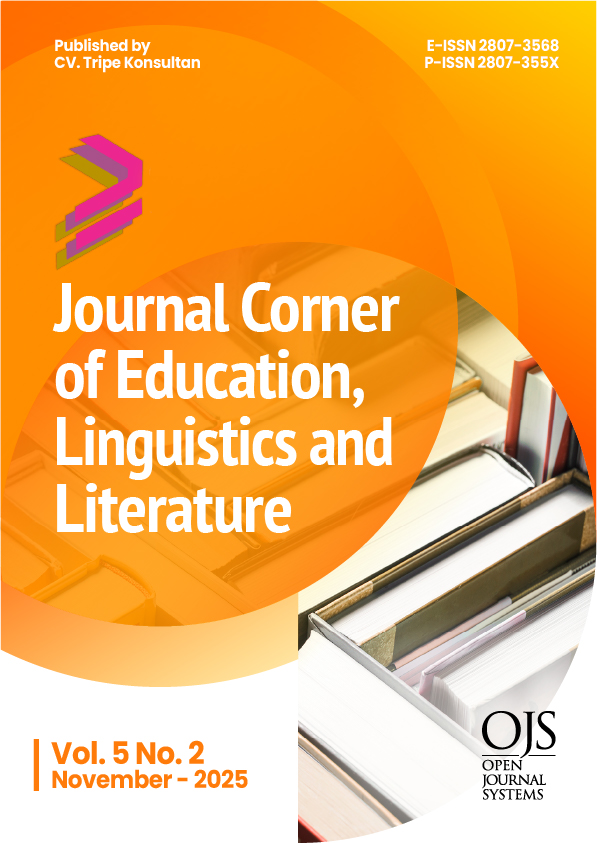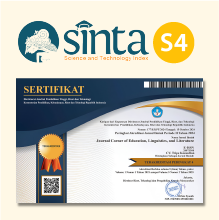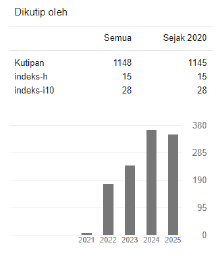Augmented Reality to Improve English Comprehension and Retention in Third-Grade Students
 https://doi.org/10.54012/jcell.v5i2.611
https://doi.org/10.54012/jcell.v5i2.611
 Abstract views: 49
Abstract views: 49
 PDF downloads: 40
PDF downloads: 40
Keywords:
Augmented Reality (AR), English Language Learning, Elementary School, Comprehension, RetentionAbstract
English proficiency at the elementary level in Indonesia remains relatively low, particularly in the Kalianda region of South Lampung, Sumatra. This issue has become a pressing concern ahead of the mandatory English policy for elementary schools starting in the 2027/2028 academic year. Indonesia’s score in the 2024 EF English Proficiency Index, ranked 80th out of 116 countries, underscores the urgency of renewing teaching methods. Currently, conventional approaches such as lectures and rote memorization dominate, while technology-based methods, including Augmented Reality (AR), are scarcely implemented at the primary education level, especially in Kalianda. The primary objective of this study is to develop and implement AR-based learning media to enhance the comprehension and retention of English materials among third-grade elementary students in Kalianda, South Lampung. The study employs a Research and Development (RnD) approach using the ADDIE model (Analysis, Design, Development, Implementation, Evaluation). The research subjects comprised 134 third-grade students from five elementary schools in Kalianda, selected through cluster sampling. The AR application is developed by considering the distribution of basic English materials and an age-appropriate user experience for elementary students. Findings indicate that AR enhances comprehension and retention by providing interactive, multi-sensory experiences that support differentiated learning. Low-performing students achieved substantial improvements, while higher-performing students advanced further. No declines in scores were observed, highlighting AR’s effectiveness in creating an engaging, safe, and motivating learning environment that fosters meaningful, long-term learning outcomes.
Downloads
References
Chhabhaiya, N., Patle, B., & Bhojane, P. (2024). Virtual & augmented reality applications: A broader perspective. Journal of Data Science and Intelligent Systems, August 2023, 1–13.
Coffin, P. (2020). Implementing collaborative writing in EFL classrooms: Teachers and students’ perspectives. Learning: Journal of Language Education and Acquisition Research Network, 13(1), 178–194.
Fauziyah, L. S., Sugiman, S., & Munahefi, D. N. (2024, February 11). Transformasi pembelajaran matematika melalui media augmented reality: Keterlibatan siswa dan pemahaman konseptual. In PRISMA, Prosiding Seminar Nasional Matematika (pp. 936–943).
Firmansyah, D. (2015). Pengaruh strategi pembelajaran dan minat belajar terhadap hasil belajar matematika. Jurnal Pendidikan Unsika, 3(1), 34–44.
Gottschalk, F. (2019). Impacts of technology use on children: Exploring literature on the brain, cognition and well-being. OECD Education Working Papers, 26(3), 313–316. https://doi.org/10.1787/e071a505-en
Gurning, B. (2008). Fungsi bahasa dalam pembelajarannya. Jurnal Bahas Unimed, 69.
Hallas, J. (2008). Rethinking teaching and assessment strategies for flexible learning environments. In Ascilite 2008 (pp. 10–11). http://ascilite.org.au/conferences/melbourne08/procs/hallas.pdf
Hartati, D. (2022). Upaya peningkatan minat dan hasil belajar Bahasa Inggris melalui pemanfaatan multimedia interaktif di SMAN 2 Batanghari. Paedagogy: Ilmu Pendidikan dan Psikologi, 2(2), 125–131.
Irma, I., Arsyad, A., & Safe’i, B. (2019). Pengembangan bahan ajar teknologi pembelajaran berbasis web-blog pada mahasiswa Fakultas Tarbiyah dan Keguruan Universitas Islam Negeri Alauddin Makassar. UIN Alauddin Makassar, 7(1), 278.
James, W., Pennebaker, M. R. M., Niederhoffer, & K. G. (2003). Learning a natural language interface with neural programmer. Psychology. http://arxiv.org/abs/1611.08945
Joksimovic, S., Gasevic, D., Kovanovic, V., Adesope, O., & Hatala, M. (2014). Psychological characteristics in cognitive presence of communities of inquiry: A linguistic analysis of online discussions. The Internet and Higher Education, 22, 1–10. https://doi.org/10.1016/j.iheduc.2014.03.001
Keser, H., & Semerci, A. (2019). Technology trends, Education 4.0 and beyond. Contemporary Educational Research Journal, 9(3), 39–49.
Kusuma, H. A., & Apriyanto, S. (2018). Strategy on developing English learning material for specific purposes. International Journal of Education, Curriculum and Application (IJECA), 1(3), 39–44.
Muliasari, D., & Efendi, T. F. (2023). Pengaruh penggunaan aplikasi pembelajaran adaptif terhadap peningkatan prestasi belajar mahasiswa pada mata kuliah bahasa Inggris di Institut Teknologi Bisnis Aas Indonesia. Edunomika, 7(2), 1–10.
Mustaqim, I. (2016). Pemanfaatan augmented reality sebagai media pembelajaran. Jurnal Pendidikan Teknologi dan Kejuruan, 13(2), 728–732.
Nguyen, T. T. (2020). Artificial intelligence in the battle against Coronavirus (COVID-19): A survey and future research directions. arXiv Preprint. https://arxiv.org/abs/2004.05927
Pisica, A. I., Edu, T., Zaharia, R. M., & Zaharia, R. (2023). Implementing artificial intelligence in higher education: Pros and cons from the perspectives of academics. Societies, 13(5), 118. https://doi.org/10.3390/soc13050118
Putra, H. D., & Aswandi, A. (2023). Bispro students’ perceptions of the satisfaction of the teaching and learning process toward Strawberry Generation at the Bengkalis State Polytechnic. Journal Corner of Education, Linguistics, and Literature, 2(4), 352–358.
Putra, I. N. T. A., Kartini, K. S., & Abenk, M. I. S. (2024). Analisis fungsional dan pengalaman pengguna augmented reality pada pembelajaran pengenalan struktur tumbuhan. In Seminar Nasional Riset Inovatif.
Rahma, F. A., Harjono, H. S., & Sulistyo, U. (2023). Problematika pemanfaatan media pembelajaran berbasis digital. Jurnal Basicedu, 7(1), 609–616.
Rocca, K. A. (2010). Student participation in the college classroom: An extended multidisciplinary literature review. Communication Education, 59(2), 185–213.
Shadiev, R., & Huang, Y. M. (2016). Facilitating cross-cultural understanding with learning activities supported by speech-to-text recognition and computer-aided translation. Computers & Education, 98, 130–141. https://doi.org/10.1016/j.compedu.2016.03.013
Sirajuddin, R. L. K. (2018). Kendala pengajaran bahasa Inggris di sekolah dasar (Problems of English teaching in elementary school). Jurnal Bahasa, Sastra dan Pembelajarannya, 3(2), 244.
Tyson, M. (2021). Impact of augmented reality on vocabulary acquisition and retention. Issues and Trends in Learning Technologies, 9(1).
Usholiha, A., & Wardianto, M. (2017). Hasil belajar bahasa Mandarin ditinjau dari retensi long term memory di SMA Darut Taqwa Sengonagung Purwosari Pasuruan. Jurnal Psikologi: Jurnal Ilmiah Fakultas Psikologi Universitas Yudharta Pasuruan, 4(1), 9–18.
Zheng, T., & Feng, X. S. (2024). The application and innovation of virtual reality technology in network media. SHS Web of Conferences, 183, 02019.
Downloads
Published
How to Cite
Issue
Section
License
Copyright (c) 2025 Sigit Apriyanto, Eko Aziz Apriadi, Adelina Anum, Arum Bahari

This work is licensed under a Creative Commons Attribution-ShareAlike 4.0 International License.
All articles published in the Journal Corner of Education, Linguistics, and Literature are licensed under the Creative Commons Attribution-ShareAlike License (CC BY-SA).

















